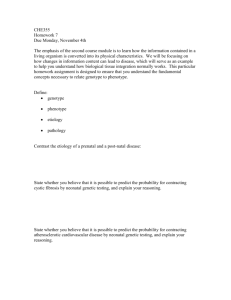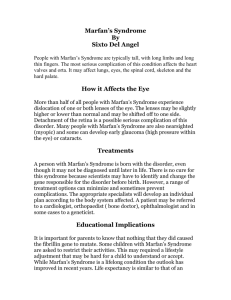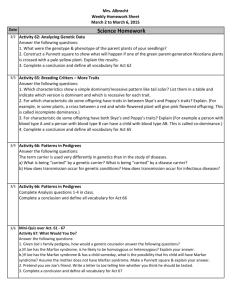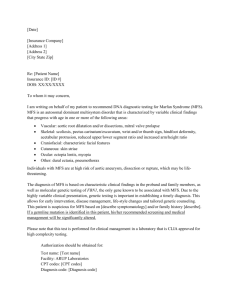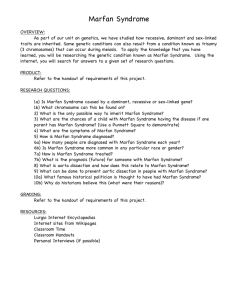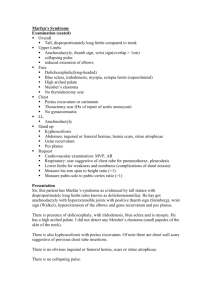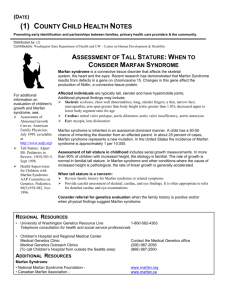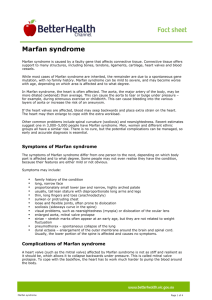MARFAN SYNDROME DEFINITION
advertisement
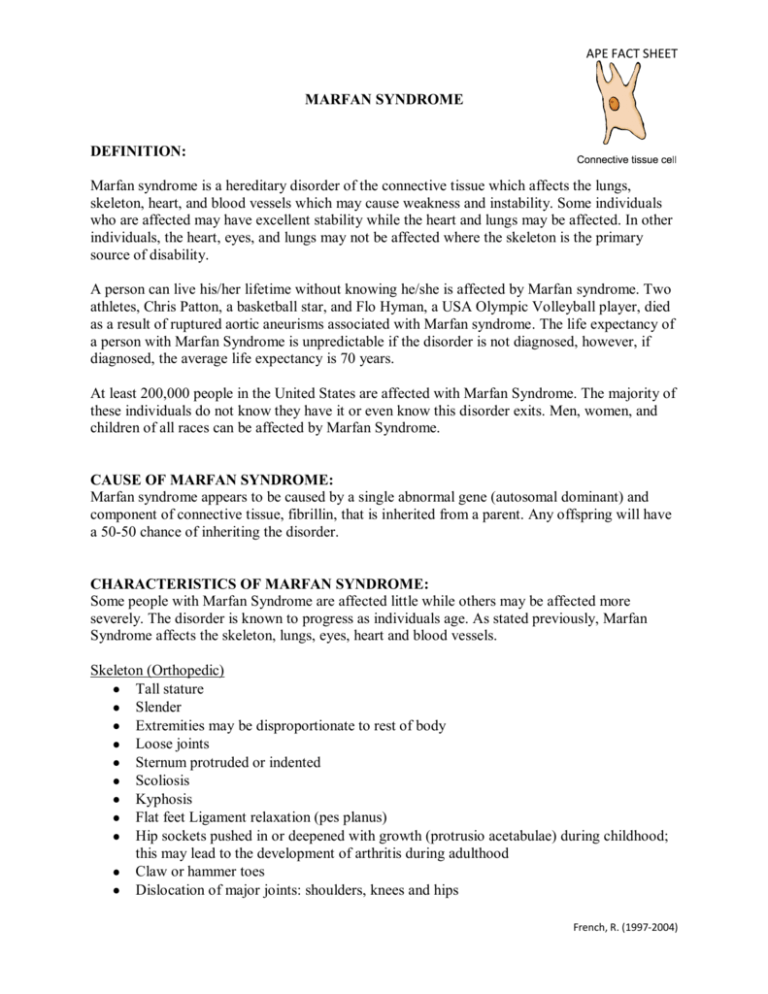
APE FACT SHEET MARFAN SYNDROME DEFINITION: Marfan syndrome is a hereditary disorder of the connective tissue which affects the lungs, skeleton, heart, and blood vessels which may cause weakness and instability. Some individuals who are affected may have excellent stability while the heart and lungs may be affected. In other individuals, the heart, eyes, and lungs may not be affected where the skeleton is the primary source of disability. A person can live his/her lifetime without knowing he/she is affected by Marfan syndrome. Two athletes, Chris Patton, a basketball star, and Flo Hyman, a USA Olympic Volleyball player, died as a result of ruptured aortic aneurisms associated with Marfan syndrome. The life expectancy of a person with Marfan Syndrome is unpredictable if the disorder is not diagnosed, however, if diagnosed, the average life expectancy is 70 years. At least 200,000 people in the United States are affected with Marfan Syndrome. The majority of these individuals do not know they have it or even know this disorder exits. Men, women, and children of all races can be affected by Marfan Syndrome. CAUSE OF MARFAN SYNDROME: Marfan syndrome appears to be caused by a single abnormal gene (autosomal dominant) and component of connective tissue, fibrillin, that is inherited from a parent. Any offspring will have a 50-50 chance of inheriting the disorder. CHARACTERISTICS OF MARFAN SYNDROME: Some people with Marfan Syndrome are affected little while others may be affected more severely. The disorder is known to progress as individuals age. As stated previously, Marfan Syndrome affects the skeleton, lungs, eyes, heart and blood vessels. Skeleton (Orthopedic) Tall stature Slender Extremities may be disproportionate to rest of body Loose joints Sternum protruded or indented Scoliosis Kyphosis Flat feet Ligament relaxation (pes planus) Hip sockets pushed in or deepened with growth (protrusio acetabulae) during childhood; this may lead to the development of arthritis during adulthood Claw or hammer toes Dislocation of major joints: shoulders, knees and hips French, R. (1997-2004) APE FACT SHEET Aches and pains in the back, legs, or feet Note: these characteristics may not occur in every individual with Marfan Syndrome. Lungs Tiny air sacs within the lungs become stretched or swollen causing the lung to collapse. Eyes Dislocation of one or both lenses of the eyes Lens may be higher, lower, or shifted to one side Retinal detachment Nearsightedness (myopia) Glaucoma Cataracts Heart and blood vessels Ninety percent of people with Marfan Syndrome will have heart involvement. The valve between left chambers of the heart is defective, large and floppy, resulting in an abnormal valve motion. This valve may leak causing a heart murmur. Small leaks of blood back into the heart may not cause any problems, but large leaks may cause an individual to have a shortness of breath, fatigue, and palpitations. Aortic enlargement may not be recognized for many years. Aortic dilation – The aorta wall is weakened and stretched causing an increased risk for tear or rupture (aorta dissection) causing serious heart problems or even sudden death. Mitral valve prolapse – an abnormal billowing motion of the mitral valve during the heart¡¯s contraction. DIAGNOSIS: There is no specific laboratory test to diagnose Marfan Syndrome. The following are tests that assist in the diagnosis of Marfan Syndrome: Echocardiogram by a cardiologist Slit-eye exam by ophthalmologist Skeletal exam by an orthopedist Complete family history TREATMENT: There is no cure for Marfan Syndrome, however, there are ways to minimize complications. Treatment includes the following procedures: Annual echocardiogram Eye examination with a slit-lamp to detect lens dislocation Monitoring of the skeletal system especially during childhood and adolescence Beta blocker medications to reduce stress on the aorta French, R. (1997-2004) APE FACT SHEET Antibiotics used prior to dental work to reduce the risk of infection in people who experience mitral valve prolapse. PHYSICAL ACTIVITY GUIDELINES: Avoid contact sports because of the risk of damaging the aorta. Avoid strenuous exercise because of the stress placed on the aorta. It is important to exercise and to continue aerobic exercise. Perform these activities at a 50% work level. Avoid weightlifting, climbing steep inclines, and pull-ups. If lifting weights, use multiple repetitions with light weight. If cycling, keep the tension low. Avoid activities that have frequent changes in atmospheric pressure such as scuba diving and flying in an unpressurized aircraft. Children diagnosed with Marfan Syndrome should be referred for Adapted physical education. PREGNANCY AND MARFAN SYNDROME: Stress of pregnancy may cause extra aortic enlargement. If the aorta is enlarged, the risk of dissection is higher Echocardiograms should be performed in the first, second, and third trimester of pregnancy. If the aorta enlargement progress, women may be placed on bed rest or hospitalized to reduce the pressure. Caesarian section may be performed if labor becomes prolonged. RECOMMENDED WEB SITES: National Marfan Foundation National Institute of Arthritis and Musculoskeletal and Skin Disease (NIAMS) National Human Genome Research Institution (NHGRI) American Heart Association Content created by Andrea D. Woodson, Ph.D. Candidate, Texas Woman’s University, 2003. French, R. (1997-2004)
